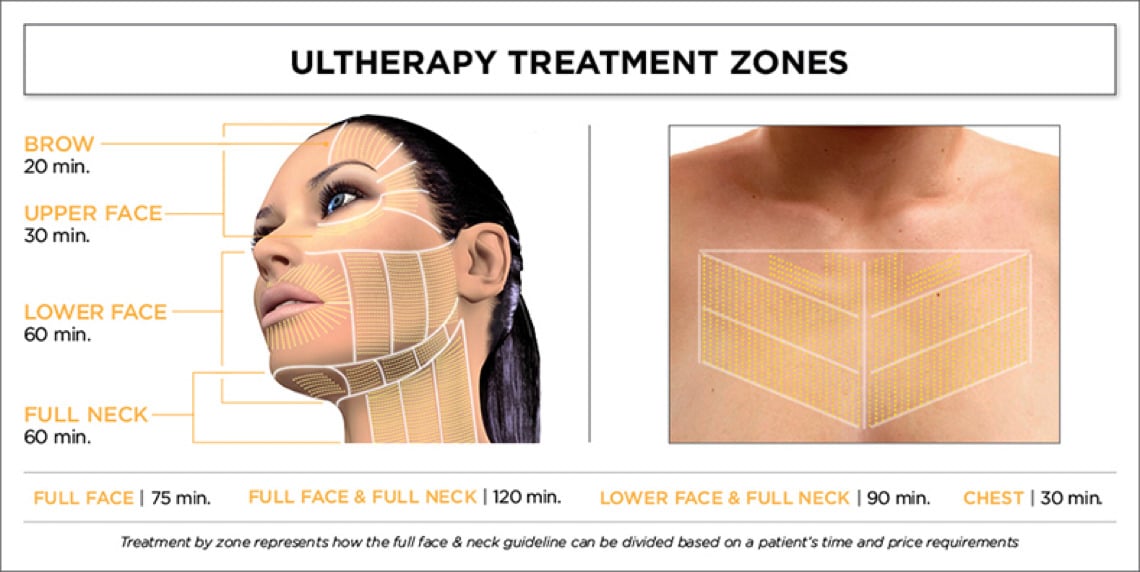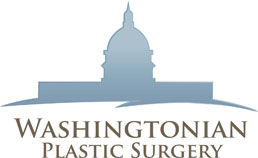What Is Ultherapy?
A Deeper Non-Surgical Lift
Ultherapy is the only non-invasive treatment approved by the FDA for lifting the skin. It slows down the signs of aging using microfocused ultrasound to non-invasively treat the same deep tissue planes as a modern facelift. This treatment lifts and tightens loose skin over time, without any downtime. It is the only technology that precisely and consistently heats tissue to the optimal temperature for collagen contraction and denaturation at specific depths. Lifting occurs over time (the next 6 months) when the body’s wound-healing response repairs the “injury” caused by the heat and builds new collagen.

Benefits of Ultherapy
- Non-surgically lifts, tones, tightens, smoothes the skin
- Stimulates collagen regrowth
- No downtime and results can be seen with one treatment
- Treats the skin deepest layers without surgery (non-invasive)
- Safe for all skin types at any time of the year
- Provides natural-looking, noticeable results
- Clinical proven efficacy and safety profiles
- Results can last 1-2 years
Is it Right for You?
No one can stop the aging process, but we can try to slow it down. Signs of aging varies between individuals’ genetic factors, environment, nutrition, and self care. Smoking, exposure to sunlight, environmental factors, stress, and an unhealthy diet can accelerate the loss of collagen.
While Ultherapy is not a replacement for a surgical face lift, there are many people who want some lifting but are not ready for surgery, either mentally, physically, or financially. Ultherapy combined with fillers and other injectables can plump, tone, tighten and add volume to aging skin. Younger people who want to “stay ahead of the game” as well as those looking to prolong the effects of cosmetic surgery can also benefit from Ultherapy.
A good candidate for Ultherapy is someone with skin that has some degree of laxity, to the point of looking, and often feeling, less firm. A lowered eyebrow line or sagging skin on the eyelids, for instance, is often the first sign of “maturing” skin. Loose skin under the neck and under the chin signals a patient might be a candidate. Typically, those in their thirties and older who have mild to moderate skin laxity are candidates.
Treatment Areas
Ultherapy is the only non-invasive treatment approved by the FDA for lifting the skin on the neck, décolletage (upper chest), chin, and brows. It can also be used to help tighten the knees, upper arms, elbows, and small areas of the lower belly or thighs.

Results of Ultherapy
Results vary from patient to patient, depending on the body’s ability to produce new collagen. You will be able to feel your skin firming over the course of the 1-3 months. Typically final results peak around 6 months after treatment.
How much Does Ultherapy Cost?
When you come in for your consultation, we will discuss your skin lifting goals and give you the tailored treatment options with their fees. The total cost of an Ultherapy treatment depends on the area or areas you are treating. One session can cost anywhere from $300 to $5,000.
Preparing for your Ultherapy Treatment
Please stop blood thinning medication, as bruising is possible. Over the counter medications like aspirin, daily large dose anti-inflammatories and fish oil supplements may also exacerbate bruising and should be discontinued. If you are unsure about whether your medications are blood thinners please feel free to give us a call to confirm.
Since bruising and minor swelling is possible, we recommend starting arnica gel or supplement 3-5 days prior to treatment and continue for about a week. Arnica is is a natural homeopathic herb that has shown to reduce bruising and swelling and is available at most health food stores.
On the day of your Ultherapy treatment please:
- Avoid wearing make up and jewelry.
- Wear comfortable, loose clothing to your appointment.
- Thirty minutes prior to your treatment we recommend that you take 800 mg of ibuprofen for pain relief during the session.
What to Expect During Your Ultherapy Treatment
Prior to the procedure, photos are taken and the area to be treated will be marked to outline the treatment area. The Ultherapy device allows the provider to visualize the internal layers of the skin using ultrasonic visualization. Once the provider determines exactly where the energy will be deposited, a series of pulses are delivered to the treatment area. The pulses are brief, and many patients describe the sensation as small pricks to the skin. A chilled ultrasound gel is used during the treatment and can help improve patient comfort. The treatment usually takes about 30–90-minutes, depending on the treatment area.
What to Expect After Your Ultherapy Treatment
Ultherapy has zero downtime, and patients may resume all normal activities post-treatment. There may be slight redness for up to an hour or so following the treatment, and a small percentage of patients may have slight swelling, tingling or tenderness to touch, but these are mild and temporary in nature. Possible side effects immediately following the procedure are:
- Bruising, swelling and tenderness can occur in the treated area. Bruising may not be evident for several days following the treatment and often is greenish in color by the time it becomes visible. Most common areas for bruising are along the jawline and cheekbone.
- Even without bruising, tenderness to the touch is expected. This is usually most evident along the jawline and cheekbone and most often noted when touching your face, washing or applying makeup. This will not interfere with eating, talking or moving your facial muscles.
- Irritation of peripheral sensory or motor nerves is uncommon but can happen. This can result in temporary patches of decreased sensation or some weakness of facial muscles (usually the muscle which pulls the corner of the mouth downward). When this occurs it is always temporary and usually resolves within three weeks.
Keep it up!
After your treatment, we will track you collagen building progress. Appointments are set up at one month, 3 months, and 6 months, and a set of photos will be taken at each appointment to see your progress. Future maintenance treatments on smaller areas can help keep pace with the aging process, which varies by individual. Depending on the skin response, it may be necessary to carry out a new session after about two years to counteract the natural skin aging process.
Interested in having an Ultherapy treatment?
If you are interested in having an Ultherapy treatment, please call our office today to schedule a comprehensive consultation!
How Ultherapy Is Revolutionizing Non-Surgical Facelifts
Discover the Non-Surgical Way to Lift and Tighten Your Skin: Ultherapy Aging is inevitable, but looking your age is optional. While we can’t turn back [...]
Unlocking the Secrets to a More Sculpted Face: What Causes Facial Fat & How to Reduce It
Your face is the first thing people notice about you—it shapes your overall appearance and can influence how youthful and defined you look. But for [...]
Everything You Need to Know About Enhancing Your Lips and the Area Around Them
Your lips and the skin around your mouth play a starring role in how you look and express yourself. They frame your smile, highlight your [...]






